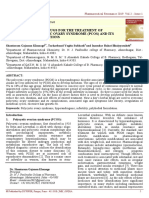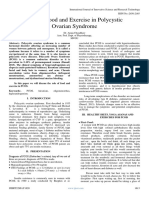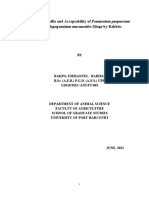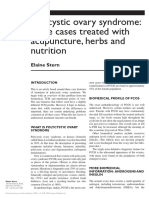Phytochemical Interventions For Polycystic Ovary Syndrome: (PCOS) Systematic Review
Phytochemical Interventions For Polycystic Ovary Syndrome: (PCOS) Systematic Review
Volume 9, Issue 10, October– 2024 International Journal of Innovative Science and Research Technology
ISSN No:-2456-2165 https://doi.org/10.38124/ijisrt/IJISRT24OCT1816
Phytochemical Interventions for Polycystic Ovary
Syndrome : (PCOS) Systematic Review
Vruttika Katore1; Amruta Bhingare2
1
Under Graduate Scholar, Jagadmba Education Society’s S.N.D.College of Pharmacy Babhulgaon, Yeola .
2
Assistant Pofessor, Jagadmba Education Society’s, S.N.D.College of Pharmacy Babhulgaon, Yeola.
Abstract:- Worldwide, 2.2-26% Many women who are This emphasizes the necessity of thorough knowledge,
fertile experience PCOS, a complicated the Endocrine, prompt diagnosis and efficient management techniques.[1]
metabolic, and genetic condition. Pale menstruation, PCOS is still a complicated and mysterious disorder that does
infertility, hirsutism, acne, and insulin resistance are not respond well to a single therapeutic intervention because
some of the symptoms of PCOS, which is typified by its mechanism is unknown. The basic processes causing this
polycystic ovaries, persistent anovulation, and illness remain unclear despite a great deal of investigation.
hyperandrogenism. While they come with risks and With genetic and environmental variables interacting to affect
adverse effects, conventional treatments frequently target gene expression and contribute to the development of PCOS,
specific ailments. Herbal remedies, on the other hand, there is emerging evidence that the condition may have
present a viable, low-risk substitute. The effectiveness of epigenetic roots. Understanding PCOS is complicated by this
several botanicals, such as Ashoka, Shatavari, Lodhra, epigenetic component, which makes it difficult to find a
Guduchi and Haritki in reducing PCOS symptoms is treatment that works for everyone. This underscores the
highlighted in this review. These herbs improve ovarian necessity for ongoing study into the basic biology of PCOS,
morphology and lower hyperandrogenism; they also have as present therapeutic approaches frequently concentrate on
hypoglycemic, anti-obesity, and hormone-regulating treating symptoms rather than the underlying reasons.[2] The
qualities. Other herbs that are useful for hormone pathogenesis of PCOS is uncertain, however it is certainly
imbalance, reproductive dysfunction, depression, influenced by epigenetic factors. Its development is
menstruation include The plants Phyllanthus emblica and influenced Life quality is significantly impacted negatively
Bauhinia variegata. Bellirica terminalia. Hypericum by PCOS, effective treatment challenging. Current
perforatum with Tribulus terrestris. anomalies. Notably, management options Despite growing research, the
there have been no documented adverse effects and these underlying mechanisms are still not well understood, and
phytotherapeutic approaches are well tolerated. The goal most treatments focus more on symptom relief than the
of this review is to compile the body of research regarding underlying causes [3, 4] Because of its efficacy and safety
the use of natural plants to treat PCOS, with a focus on record, herbal formulations have grown in popularity in
the possibility of herbal formulations as a safe, effective, recent years. Unlike conventional medicines, herbal remedies
supplemental management strategy for condition. have a much wider range of active components and fewer side
effects. Specifically, herbs like Ashoka, Shatavari, Lodhra,
Keywords:- PCOS or Polycystic Ovarian Syndrome , Guduchi, Tulsi, and Haritki have a history of being effective
Ovarian Morphology , Hypoglycemic Consequences , in treating a variety of conditions. That's why everyone
Hormone Regulation Alternative and Complementary searching for natural medicines should consider them. [5]
Therapies, Ashoka, Shatavari, Lodhra, Guduchi ,Tulsi and
Haritaki. Limitations of Conventional Treatments
Traditional Western medicine, surgery and treatments
I. INTRODUCTION often focus on alleviating specific symptoms, sbut may be
accompanied by risks, side effects, and interactions. These
Millions of women worldwide who are of reproductive conventional methods can be inadequate, ineffective, or even
age suffer from PCOS, an endocrine illness that is complex harmful in some cases.
and varied. In addition to its characteristic polycystic ovarian
shape and prolonged oligoanovulation, PCOS is frequently Emerging Role of Herbal Formulations
accompanied by a variety of metabolic disorders and Fortunately, complementary and alternative medicine
psychosocial problems. A crucial metabolic dysfunction offers promising solutions. Herbal formulations containing
Compiling the body of knowledge on the usage of natural extracts of Ashoka , Lodhra, Shatavari, Tulsi , Guduchi ,
plants is the aim of this review. These insulin-related Haritaki have garnered attention for their natural, due to the
problems have far-reaching effects, since they interfere with interplay between environmental and genetic variables,
the metabolism and synthesis of androgens, resulting in a creating the. These plants' complex chemical constituents
variety of symptoms such as obesity, infertility, monthly exhibit significant effects on PCOS, despite their mechanisms
abnormalities, and hyperandrogenism. Because of this, The of action being partially understood. Marketed formulations
core causes of PCOS are compensatory hyperinsulinemia and combining these herbs have received positive feedback from
insulin resistance. long-term wellbeing is afflicted women. PCOS patients.[1,2]
IJISRT24OCT1816 www.ijisrt.com 2541
Volume 9, Issue 10, October– 2024 International Journal of Innovative Science and Research Technology
ISSN No:-2456-2165 https://doi.org/10.38124/ijisrt/IJISRT24OCT1816
Objective: LHRH, or luteinizing hormone releasing hormones, are
This article aims to summarize the most effective herbs produced by the hypothalamus.then stimulate this
and formulations playing a critical role in PCOS treatment, pituitary gland.
highlighting their potential to modulate serum hormone levels Women's ovarian follicle stimulation is regulated by
and ovarian morphology. By exploring these plant-based both the hormones FSH and LH.
herbal formulations, we may uncover new bioactive products Progesterone and estrogen are hormones that are
and advance ourunderstanding of PCOS management. [1] produced by the ovaries. Maintaining the balance of these
hormones controls the menstrual cycle.
A number of conditions include compensatory There are three stages to the menstrual cycle stages
hyperinsulinemia, which may be the cause of altered include the ovulatory, luteal / secretory, and follicular
androgen production and metabolism in reproductive age, proliferative stages.
chronic oligoanovulation, polycystic ovarian morphology, Hormonal tablets which are also used for birth control are
psychological problems, and metabolic abnormalities, used to treat irregular menstrual periods.[11]
primarily insulin resistance.[2]
II. TREATMRNT OF PCOS WITH
Types of PCOS: HERBAL INGREDIENT
PCOS is Classified into various types,
Ashoka:
Post-Pill PCOS, The plant is known as Saraca asосa. The Legumenosae
Adrenal PCOS, family Tree parts that are named after the word "ngsuffering."
Inflammatory PCOS, Ashoka has a number of therapeutic uses. For its many health
Insulin Resistance PCOS, advantages, the Ashoka tree is well known. Ashoka leaves
and bark are sometimes used to treat women with menstrual
Causes of PCOS: disorders, including as dysmenorrhea stomachaches, and
uterine spasms. Numerous tannins, flavonoids, and
PCOS is caused by genetic susceptibility. glycosides found in Ashoka tree bark constitute uterine tonic
The relationship between fat and insulin resistance beverages. Ashoka tree roots and seeds are used to treat skin
Adrenal gland activation is high in children. conditions such dermatitis, psoriasis, and acne in PCOS.
imbalance in hormones. Buildup of toxicity Ovarian and Discomfort and stomach spasms caused by Ashoka tree tea
uterine inflammation under stress that affect the uterine muscles and endometriumAdditional
disorders related to irregular menstrual periods, leucorrhea,
Additional Factors Contributing to PCOS fibroids, cysts and amenorrhea [12] further connected issues,
As such, ashoka is frequently used in the treatment of
Environmental factors (e.g., exposure to endocrine women's gynecological and menstrual diseases. [13]
disruptors)
Lifestyle factors (e.g., poor diet, sedentary lifestyle) ,
Family history ,
Ethnicity (e.g., higher prevalence in South Asian women)
Early menarche ,
Childhood obesity
Pathophysiology of PCOS
Hormonal imbalance (e.g., hyperandrogenism, insulin
resistance
Insulin resistance and metabolic disorders ,
Inflammation and oxidative stress [6,9]
Menstrual Cycle Problem:
The most typical signs of PCOS Either amenorrhea or
oligomenorrhea are the most common symptoms of
PCOS. But it might also result in other issues related to
menstruation. [10] Fig 1 Ashoka Bark
It is said that hormones influence the menstrual cycle in
females. Lodhra :
The ovaries, the pituitary gland, and the hypothalamus The plant is known as Symplocos racemose The
regulate when it starts. Symplocaceae Family In Ayurveda medicine, lothara is a
Through the pituitary gland, luteinizing hormone (LH) highly prized plant that treats problems specific to women.
and follicle-stimulating hormone (FSH) are released. Because it is a flexible plant, lodhra is used in the Indian
IJISRT24OCT1816 www.ijisrt.com 2542
Volume 9, Issue 10, October– 2024 International Journal of Innovative Science and Research Technology
ISSN No:-2456-2165 https://doi.org/10.38124/ijisrt/IJISRT24OCT1816
medical system, both independently and in combination heal
and in combination with other herbs in different formulations.
S. racemosa has been shown to be benefit in treating
Polycystic Ovary Syndrome (PCOS) Sin studies using a
letrozole-induced female rat model. Important changes in
ovarian tissue health, estrogen, testosterone, and
progesterone levels have been seen. S. racemosa is a
prospective therapeutic agent for the management of
postpartum depression (pcod) due to its ability to boost
fertility and avoid ovarian cell failure. Fifth, a crucial plant in
Ayurveda medicine used to treat feminine diseases is
Symplocos racemosa (Lodhra) (Family: Symplocaceae).
Studies indicate that it is effective in managing PCOS.
Enhancing the amounts of hormones estrogen, testosterone,
progesterone) and ovarian health, thereby promoting fertility
and preventing ovarian cell failure.[14,15]
Fig 3 Shatavari
Tulsi :
The plant is known as Ocimum sanctum linn The
lamiaceae family Hypoglycemia and obesity are the two main
medical conditions for which the holy herbal plant tulsi is
used [19]. It treats polycystic due to its anti-androgenic
qualities, which can help prevent ovarian syndrome. It
prevents the synthesis of testosterone and regulates fat. [20]
Since there is no proper ovulation mechanism, There is no
androgen usage by the body. Unused testosterone is the
Unused androgens are the root cause of acne and hirsutism.
Maintaining and using androgen levels appropriately is
Tulsi's role. Moreover, it possesses antioxidant qualities51.
[21]
Fig 2 Lodhara
Shatavari:
The plant is known as Asparaus racemosus The
Asparagus family The medicinal plant known as Asparaus
racemosus is known by its Sanskrit name, shatavari. The
plant's dried roots are used as medicine because they contain
phytoestrogen. stimulates the growth of ovarian follicles,
regulates the menstrual cycle, and revitalizes the female
reproductive system. [16] With several health advantages,
shatavari is regarded as one of the most important Ayurvedic
herbs. It is a main component in a lot of Ayurvedic recipes.
Typically it is a spiny, branching, woody, climbing shrub that
can reach heights or lengths of 1-2 feet. [17] The roots have
Fig 4 Tulsi
a diuretic, tonic, and medicinal function that increases
cytoprotection and mucosal resistance. It also helps to
Guduchi:
dissolve cysts and stop new cysts from growing,
The plant is known as Tinospora cordifolia The
curehyperinsulinemia.Shatavari treats neuropathy,
Msenispermaceae family The Guduchi Numerous therapeutic
inflammation, tumors, and dyspepsia. It functions to regulate
effects, such as The medicinal herb Menispermaceae is linked
the HPO axis and hormone levels. [18]
to ovarian balance, an anti-inflammatory, an anti-stress, and
IJISRT24OCT1816 www.ijisrt.com 2543
Volume 9, Issue 10, October– 2024 International Journal of Innovative Science and Research Technology
ISSN No:-2456-2165 https://doi.org/10.38124/ijisrt/IJISRT24OCT1816
hypoglycemia. It is the stem portion that the pants employ. diphenylpicrylhydrazyl. Consequently, it has anti-
Using guduchi mostly for PCOS treatment. Ovarian cysts and inflammatory properties. qualities. Phenolic chemicals,
irregular insulin levels are the main causes of tissue which are present in triphala extracts, have the property of
inflammation. Anti-inflammatory qualities are proposed for scavenging free radicals.These substances mainly help to
guduchi.. It helps the body's defenses against disease. Insulin relieve the problem of irregular menstruation by altering
resistance is a condition developed by women with PCOS, hormone control.[24] "Tridoshic Rasayana" is described in
and it helps to overcome. It is also a plant that controls Ayurveda as a medicinal substance that influences the vata,
menses. [22,23] pitta, and kapha energies, which are the three constitutional
energies.Its effects on these energies are balanced and
revitalizing. Ayurveda believes that triphala is a blend of
Pitta, Kapha, and Vatta, which makes it cleansing and well-
balanced. Tridoshic Rasayana is a therapeutic substance that
has the ability to balance and rejuvenate the three humors.
(Vata, Pitta, and Kapha), is how triphala is referred to in an
ancient Ayurvedic source a has a cold temperament, Harad,
Baheda, and Amala have warm energies. Triphala as a
medicine for internal cleaning and detoxification, is balance
and effective because its including all [25]
Fig 5 Guduchi
Haritaki
The plant is known as: Terminalia chebula The
Combretaceae Family Three fruits Amla, Haritaki, and
Baheda can be combined or mixed to form a "triphala".
Triphala, a plant that is rich in natural vitamin C and
antioxidants,It is used because of its anti-inflammatory
properties to treat PCOS. Triphala not only has cleansing and
purifying properties, but it also aids in PCOS treatment.
Triphala scavenges two types of radicals: superoxide and Fig 6 Haritaki
Table 1 Hrebal Ingredient with Chemical Constituent
Herbal Ingredient Chemical Constituent
Alkaloids Glycoside Flavonoids Tannins Saponine
1.Ashoka Ashokaline, Ashokaside, Quercetine, Catechine, Ashokasaponins
Ashokine. Saracoside. Kaempferol. Gallicacid
2.Lodhra Lodhrie, Lodhroside, Quercetin, Catechine, Lodhrasaponine
Symplocine, Symploside Kaempferol Gallicacid
Symplocoside
3.Shatavari Asparagamine, Shatavaroside, Quercetine Catechine, Shatavarins ,
Racemosine Asparagoside Gallicacid Asparaoside,
Isorhapointigenin Racemoide
4.Tulsi Ocimine, Tulsin, Quercetine, Catechine, Ocimumoside,
Sanctamine Ocimuoside Kaempferol. Epicatechins, Ursolicacid
Proanthocynaides saponin
5.Guduchi Tinosporine, Tinoside, Quercetine, Gallicacid, Tinosporol
Cordifoline, Cordifoside, Kaempferol. Ellagic acid,
Palmatine Guduchioside Naringenin, Chebulogic acid,
Apigenin Corilagin
6.Haritaki Chebuline, Chebuloside, Quercetine, Gallicacid, Tinosporol,
Chebulin, Arjunolic acid, Kaempferol. Ellagic acid, Cordilfol,
Terminaline Trerminolic acid Chebulogic acid, Guduchisaponin,
Corilagin Berberine
IJISRT24OCT1816 www.ijisrt.com 2544
Volume 9, Issue 10, October– 2024 International Journal of Innovative Science and Research Technology
ISSN No:-2456-2165 https://doi.org/10.38124/ijisrt/IJISRT24OCT1816
III. CONCLUSION [12]. Lai L, Flower A, Moore M, Prescott P, Lewith G.
Polycystic ovary syndrome: A randomised feasibility
Herbal medicines offer a safe and effective approach and pilot study using Chinese Herbal medicine to
to managing Polycystic Ovary Syndrome(PCOS) and other explore Impact on Dysfunction (ORCHID) – study
reproductive disorders in women. Utilizing single herbs or protocol. Eur J Integr Med 2014;6:392-9
combinations, such , Ashoka , Lodhra, Shatavari, Tulsi , [13]. Pachiappan S, Ramalingam K, Balasubramanian A. A
Guduchi , Haritaki can provide therapeutic benefits without review on phytomedicine and their mechanism of
adverse side effects. The synergistic effect of combining action on PCOS. Int J Curr Res Rev 2020;12:81.
herbs amplifies their pharmacological effects, making [14]. Abirami S, Pushpalatha A, Vijaymurugan V, Jansirani
selection of appropriate herbs and combinations crucia. D, Selvi ST, Anjugam T, et al. efficacy of madhurigai
sombu chooranam in the treatment of Sinai Pai
REFERENCES neerkatti. Asian J Pharm Res Dev 2020;8:83-7
[15]. Moini Jazani A, Nasimi Doost Azgomi H, Nasimi
[1]. Ande SN, Pavitrakar KN, Bakal RL, Kochar NI. A Doost Azgomi A, Nasimi Doost Azgomi R. A
comprehensive review on promisable herbal drugs for comprehensive review of clinical studies with herbal
mitigation of polycystic ovarian syndrome. Innov medicine on polycystic ovary syndrome (PCOS).
Pharm Pharmacother 2022;10(2):35-40 Daru 2019;27:863-77.
[2]. Purohit A, Jain S, Nema P, Jain DK, Vishwakarma [16]. Kashani L, Akhondzadeh S. Herbal medicine in the
H,nJain PK, A Comprehensive Review on Tailoring treatment of polycystic ovary syndrome. J Med Plants
an Herbal Approach for Treatment of Poly Cystic 2016;15:1-5
Ovarian Syndrome, Asian Journal of Dental and [17]. Pandey AK, Gupta A, Tiwari M, Prasad S, Pandey
Health Sciences. 2022; 2(1):27-32 AN, Yadav PK, et al. Impact of stress on female
[3]. Norman RJ, Dewailly D, Legro RS, Hickey TE. reproductive health disorders: Possible beneficial
Polycystic ovary syndrome. Lancet. 2007; effects of shatavari (Asparagus racemosus). Biomed
370(9588):685-97.https://doi.org/10.1016/S0140- Pharmacother 2018;103:46-9
6736(07)61345-2 [18]. Yadav Chandra Kishor, Mishra Indra Bir, Jha
[4]. Celik O, Acbay O. Effects of metformin plus Khushboo. Critical review of Ayurvedic herbs in
rosuvastatin on hyperandrogenism in polycystic ovary treatment of Gynecological problems. International
syndrome patients with hyperlipidemia and impaired Journal of Research in AYUSH and Pharmaceutical
glucose tolerance. J Endocrinol Investig., 2012; Sciences, 2024;8(3):1-4.
35(10):905-10. [19]. Kumarapeli M, Karunagoda KP, Perera PK. A
[5]. Witchel SF, Oberfield SE, Peña AS. Polycystic ovary randomized clinical trial to evaluate the efficacy of
syndrome: Pathophysiology, presentation, and Satapushpashatavari powered drug with
treatment with emphasis on adolescent girls. J Endocr Satapushpashatavari grita for the management of
Soc 2019;3:1545-73 polycystic ovary syndrome (PCOS).
[6]. Balen A. The pathophysiology of polycystic ovary [20]. Satapathy S, Das N, Bandyopadhyay D, Mahapatra
syndrome: Trying to understand PCOS and its SC, Sahu DS, Meda M. Effect of tulsi (ocimum
endocrinology. Best Pract Res Clin Obstet Gynaecol sanctum linn.) supplementation on metabolic
2004;18:685-706. parameters and liver enzymes in young overweight
[7]. Witchel SF, Oberfield SE, Peña AS. Polycystic ovary and obese subjects. Indian J Clin Biochem., 2017;
syndrome: Pathophysiology, presentation, and 32(3):357-363.https://doi.org/10.1007/s12291-016-
treatment with emphasis on adolescent girls. J Endocr 0615-4
Soc 2019;3:1545-73.
[8]. Stener-Victorin E, Padmanabhan V, Walters KA,
Campbell RE, Benrick A, Giacobini P, et al. Animal
Models to Understand the Etiology and
Pathophysiology of Polycystic Ovary Syndrome.
Endocr Rev 2020;41:bnaa010.
[9]. Diamanti-Kandarakis E. Polycystic ovarian
syndrome: Pathophysiology, molecular aspects and
clinical implications. Expert Rev Mol Med
2008;10:e3
[10]. Tsilchorozidou T, Overton C, Conway GS. The
pathophysiology of polycystic ovary syndrome. Clin
Endocrinol (Oxf) 2004;60:1-17
[11]. Sushma, L.P. Yadava. Potential Use of Saraca Asoca
in the Management of Artavadushti w.s.r. to
Menstrual Disorders in Modern Era International
Journal of Ayurveda and Pharma Research. 2021;9
(9):69-73




















































































































